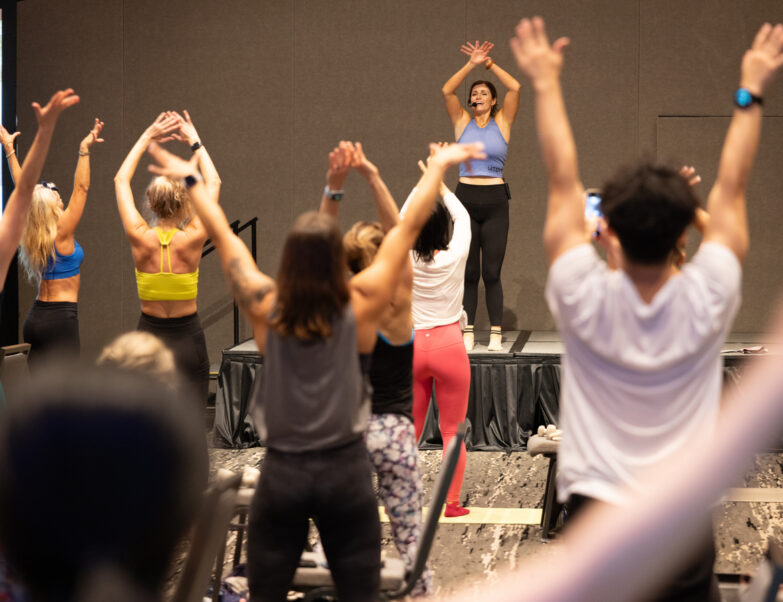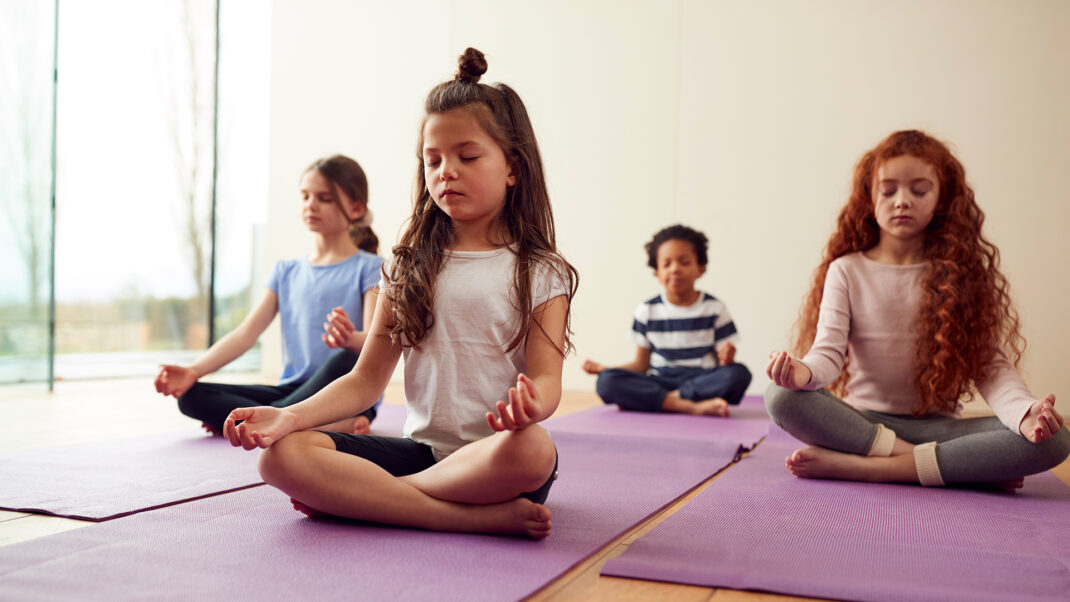Educate the Parent, Empower the Young Athlete
Here are answers to the top five frequently asked questions about youth sports development.

If you’re fortunate enough to work with children and adolescents, you’ve likely fielded thousands of questions and concerns from parents regarding the safety and validity of organized physical training. Parents are bombarded with conflicting information on this topic. Unfortunately, most of their information is based on opinion, speculation and improperly drawn conclusions. As a fitness professional, it’s important that you provide parents of your youth clients with accurate, up-to-date information based on extensive experience, research and professional correspondence. This article will address five questions you are likely to get from parents, and will provide factual, practical answers that you can easily communicate. The end result: you will help engender and foster a lifetime of fitness, wellness and successful performance.
Question #1: Proper Training Age
The first frequently asked question we’ll explore is “At what age should my child start participating in an organized training program?”
Human muscle innervation is completed around 6–7 years of age (Grasso 2005). This implies that the brain has formed its neural connections to the muscular system and that optimization of these connections can begin. This makes it more possible to perform coordinated activities. By 10–12 years of age, reflexive motor patterns are conditioned and relatively permanent (Grasso 2005). These findings suggest that introducing proper motor skills between the age of muscle innervation and the age of permanent motor pattern formation may be advantageous (Drabik 1996).
Research has demonstrated that children as young as 5 have experienced benefits from organized programs, such as resistance training (Annesi et al. 2005). However, while the neuromuscular system may be ready to acquire skill at a young age, starting on an organized regimen of any kind requires an adequate level of mental, physical and emotional maturity (Ashmore 2003; Drabik 1996; Grasso 2005). Regardless of age, the child must be able to focus, follow directions, understand coaching cues and be physically proficient enough to accomplish movements in response to cues. The criteria for beginning a program, therefore, have more to do with these characteristics than with exact chronological age (Grasso 2005). A physically and mentally capable youngster benefits from a well-designed program that increases motor coordination, strength, aerobic capacity, flexibility, bone health and a variety of other physical traits (Faigenbaum et al. 2009). Additionally, the child develops exercise habits that will mold his lifestyle for years to come.
It is essential that an organized training program for a child be safe, developmentally appropriate and engaging; it must offer the child an all-around positive experience. Much of the hesitation that parents feel is due to tales of inexperienced, overzealous coaches who implement unsafe, poorly designed programs—particularly in resistance training. During the 1970s and 1980s, data from the National Electronic Injury Surveillance System suggested that resistance training was a dangerous activity for youth, given the numerous emergency-room reports of injuries from exercises and equipment. When the data were revisited, however, researchers concluded that nearly all of the injuries resulted from improper training techniques, excessive loading, lack of adult supervision or faulty equipment (Faigenbaum et al. 2009). Current research has not discovered any overt clinical injuries during properly designed and supervised resistance training at any age (Faigenbaum et al. 2009).
To ensure that a program is properly designed, parents should seek a fitness professional or coach who is knowledgeable and experienced in youth program design. That would be you. It’s important to base your programming on general physical development as opposed to sport-specific performance (see the “Training Type” section below” for more on this topic). Furthermore, the training environment must be engaging, challenging and fun. If a child’s first experience with exercise is boring, frustrating or negative in any way, she may form unfavorable attitudes toward fitness activities for the rest of her life.
Children of any age can benefit from organized training as long as they have the physical, mental and emotional maturity to address the demands of an appropriate, well-designed program in a positive, engaging environment. Be willing to share your expertise and educational credentials with parents, to put their minds at ease. (For tips on dealing professionally with an overbearing parent, see the sidebar “Dealing With a Difficult Parent.”)
Question #2: Training Type
The second frequently asked question we’ll explore is “What type of training should a particular athlete do?”
Competition among youth sports is high, and parents often want to improve a child’s physical characteristics as they apply to a particular sport. Considering the wide array of physical capabilities—strength, balance, coordination, power, visual perception, etc.—that combine to create athleticism, sport-specific training for youth is a ridiculous notion. A recent study by the American Academy of Pediatrics (AAP) found that young people who participated in a variety of sports and other activities prior to puberty were more consistent performers, had few injuries and had longer athletic careers (AAP 2001). Regardless of the sport a youngster chooses to play, he will need to be proficient in all of the capabilities mentioned above in order to advance his level of play and learn positive exercise habits that last a lifetime.
Parents often confuse sport skills and general preparation. Every sport has a specific set of tactical skills. In soccer, for example, you must be able to dribble, pass, trap the ball and shoot. These are specific skills related to the game of soccer. These skills, however, are made up of more general physical capabilities, such as strength, coordination, balance, mobility, etc., that aid in creating overall athleticism. Even this wide range of general physical capabilities can be broken down into primary physical attributes, such as rhythm, kinesthetic differentiation, body awareness, movement adequacy and a host of others (Drabik 1996; Grasso 2005). If you focus your training primarily on a specific skill set, you ignore the important foundations of that skill set. You don’t build a skyscraper from the top down. Like any structure with a poor foundation, training that skips the basics is bound to have problems down the road.
The less experienced a child is with physical movement, the wider the range of physical abilities you must address. As the child becomes proficient in basic abilities, you can introduce more specific skill sets. A young or physically inexperienced client should begin with movements that require very general physical abilities. Good choices include exercises and games that require skipping, marching, hopping, grasping, crawling, climbing, rolling, catching, throwing and kicking (Drabik 1996; Grasso 2005). When the child can accomplish these tasks well, it’s time to move on to more specific preparatory activities, such as running, resistance training exercises (beginning with body weight), sustained cardiovascular exercise and other related athletic drills. And once the child has mastered these skills, you can maintain constant improvement by increasing and manipulating load, resistance and criteria for success.
A well-designed program for a child client should be based on improving a variety of physical skills in a positive, engaging environment that teaches fitness as a way of life. The actual skills involved depend on an individual’s mental and physical developmental level, preparedness and proficiency. Communicate clearly with parents regarding their child’s stage and the steps required to meet goals.
Question #3: Growing Pains
The third frequently asked question we’ll explore is “What can we do to decrease growth-related pain maladies?”
Growth-related pain maladies, or “growing pains,” are common in children ages 8–15 (Peck 1995). Repeated mechanical stresses introduced by athletics can exacerbate these problems (DiFori 1999). The most common challenges involve knee pain (Osgood-Schlatter disease) and heel pain (Sever’s disease) immediately prior to, and during, the initial phases of puberty. The pain can be excruciating and can prevent some children from participating in physical activity.
It’s important to address and understand the mechanism behind the growth-related pain. Muscles attach to bone via tendons at specific attachment points on the bone. As a youngster’s bones grow in girth and length, new tissue at the ends of the bones is relatively “soft.” When a tendon attaches to a new “soft” area at the end of a bone—such as the tibial tuberosity for the patellar tendon (knee) and the posterior calcaneus for the Achilles tendon (heel)—the attachment’s integrity can be slightly compromised (Peck 1995). When a muscle contracts and the tendon pulls on the bone, a micro tear can occur at the tendon insertion point (DiFori 1999; Ghlove et al. 2007; Peck 1995). While this tear is minute, it triggers an inflammatory response. When muscle contraction is repeated at a high rate and force, inflammation increases, presenting pain and swelling at the insertion point. This process can continue until the area of bone at the tendon insertion point has matured, usually after peak growth velocity in the later stages of puberty (DiFori 1999; Ghlove et al. 2007; Peck 1995).
There are measures you can take to decrease the severity and duration of pain. Improving the flexibility of muscles involved with the particular tendon insertion that hurts might reduce the inflammatory response. A good program design will include daily flexibility exercises, as well as a proper warm-up (including joint range-of-motion work) prior to activity. This strategy will increase the pliability of muscles and tendons and decrease the constant tension at the tendon insertion. Have the client hold stretches for 20–30 seconds at a moderate pain tolerance (7 on a scale of 1–10). Perform warm-up activities for about 15–20 minutes prior to athletic activity (Ashmore 2003).
To reduce inflammation, apply ice to the affected area after activity. Nonsteroidal anti-inflammatory agents, such as ibuprofen, may also be used (Ashmore 2003; Peck 1995). Most important, do an overall assessment of the client’s total activity levels. It has been determined that 30%–50% of pain experienced by active youth is from overuse (Watkins & Peabody 1996). To prevent overuse problems, do not let total training volume increase more than 10% at a time (DiFori 1999; Watkins & Peabody 1996). If the pain from inflammation becomes excruciating, it may be necessary to remove a child from a sport or other activity. Merely stopping activity for a short time is not a long-term solution, however. Only by being proactive with the preventive methods described above will you lessen the severity and duration of pain on an ongoing basis.
To decrease growth-related pain in young clients, always include a proper warm-up, stretches and icing as part of the daily routine. In addition, monitor activity volume to prevent overuse. Consult with a licensed, experienced healthcare professional, such as a physical therapist or physician, prior to working with a client who has a growth-related pain malady. Give parents frequent updates on their child’s progress and threshold measures.
Question #4: Nutrition
The fourth frequently asked question we’ll explore is “What should my young athlete be eating before and after games?”
Proper nutrition is a key component of performance at any age. Children have different nutrition needs than adults, owing to a variety of factors: children expend more energy during movement, burn more fat while exercising and are less efficient at thermoregulation (body temperature control) (Meyer, O’Connor & Shirreffs 2007). A young athlete’s accelerated activity exacerbates these differences. Poor nutrition habits before, during and after a sporting event can increase the likelihood of heat illness and dehydration, hindering performance. Repeated deficiencies can increase the likelihood of certain serious injuries and also impair growth (Petri et al. 2004). The unique demands and possible serious risks involved with a young athlete’s nutrition makes it crucial that you address this topic appropriately. While personal trainers without nutrition certification can help with basic nutrition strategies, it is important to consult with a licensed nutrition professional, such as a registered dietitian (RD).
Christopher Mohr, PhD, RD, consulting sports nutritionist for the Cincinnati Bengals and co-owner of Mohr Results in Louisville, Kentucky, says that pre- and post-workout nutrition for young clients requires thoughtful planning.
“Meal timing is important,” Mohr says. “The time you have before a game will dictate your choices. Assuming there is some time between the meal and play time, you want something that’s a little higher in carbohydrates with a moderate amount of protein. A bowl of oats with berries and nuts, for example, would work. You might also try a turkey sandwich on whole-grain bread if the meal is a little later in the day.”
Mohr says it’s important to refuel quickly after a game—ideally within 30 minutes. This is because “muscles are like a dry sponge at this time and are primed to take up more nutrients.” Mohr continues: “Again, this meal should be primarily carbohydrates with a bit of protein. Low-fat chocolate milk is a favorite of mine, or yogurt with some fruit. If you want to make your own smoothie, try one frozen banana, frozen blueberries, one cup of vanilla almond milk and a scoop of whey protein. Research shows that the combination of carbohydrates and protein postworkout helps [kids] recover and prepare for the next game or practice.”
Chicago-based Jenna A. Bell, PhD, RD, CSSD, holds a doctorate in exercise science and a master’s degree in nutrition. She adds, “Coaches and parents are often challenged to find the best pre-exercise or prerace snack for kids. I always say, keep it simple and stick to the basics. Try foods that kids are comfortable with, since nervousness often makes their bellies turn, and portability is often an issue. Try peanut butter and jelly sandwiches (great for on the road), bring a bag of pistachios and dried fruit, pack a cooler with string cheese and crackers or bring whole-wheat bagels and peanut butter. Bananas, apples, oranges and grapes are great as well. The aim is to give kids carbohydrates to help them fuel their activity. After exercise, kids are ready to restore their lost fuel, replenish nutrients and repair their muscles. I tell coaches and parents to try to give them a healthy snack within 30 minutes of exercise completion.”
Frequent hydration is also necessary before, during and after games. Sports drinks can be useful during prolonged activity, particularly in the heat (Burke, Millet & Tarnopolsky 2007). Young athletes should begin activity already hydrated and continue to consume water or sports drinks during competition (Meyer et al. 2007).
Young athletes have specific nutritional needs. Employ basic strategies within your scope of practice to ensure they meet their game-related nutritional needs. Encourage parents to consult with a licensed nutrition professional to determine the needs of their specific child. Be willing to work in concert with this allied health professional.
Question #5: Homework
The fifth frequently asked question we’ll explore is “What can we do at home to improve athletic performance?
Parents are mentors to children. Kids emulate the attitudes, behaviors and actions they witness at home. When they participate in athletics, they look to parents to understand the concepts involved in competition. Adults’ attitudes toward competition and everything it encompasses shape children’s attitudes. If a child loses a game and the parent rants about bad refereeing, other players’ poor play, the coach, the facilities and so on, the child will learn to do this as well. Alternatively, if the parent takes time to discuss the game with the child in a positive, proactive manner, the child can assess the relationship between the team’s actions and subsequent outcomes (Ginsburg, Durant & Baltzell 2006). She learns that success is a product of personal accountability. With this mindset, she can become a leader in athletics, as well as life.
Children need to view athletic competition as primarily fun, not just as a way to attain accolades, such as a college scholarship. Research has demonstrated that kids who have fun and enjoy the athletic process play longer and with greater intensity, increasing their level of success (Ginsburg, Durant & Baltzell 2006). Many adults recall childhood days spent playing sandlot baseball, driveway basketball, backyard football and a variety of other unsanctioned, unsupervised, free-form athletic activities. Without the stress of being under a high-powered coach’s watchful eye, kids laughed, played and developed skills through hours upon hours of these activities. Currently, fewer than one in five children spend any time during their week in physical activity outside of organized sports (Hofferth & Sandberg 2001). While coach evaluation is an important part of athletics, many essential, high-level game skills are developed during free, unsupervised, unsanctioned play.
In regard to what type of physical activity a youngster should do to improve athleticism, refer to the “Training Type” portion of this article. Be consistent and positive with the program, and make it progressive and fun. The child should participate voluntarily.
To facilitate athletic performance at home, encourage parents to foster appropriate attitudes and behaviors toward the governing concepts of athletics—themes like self-efficacy, leadership and fun. Urge parents to ensure that children learn to enjoy the athletic process in a positive environment that allows opportunities for free play (see the sidebar “Free-Play Programming Ideas” for more). Such encouragement, along with proper physical-development pedagogy, creates an environment in which young athletes can excel.
Answer the Call
Parents entrust their children to you to help mold and shape their fitness intelligence early in life. It’s likely many of these parents have been bombarded with misinformation that you now have a chance to correct. Counter their concerns with factual, time-tested, well-researched information. A passionate, educated network of parents, fitness professionals, coaches and healthcare professionals can revive an active youth culture in which children laugh, play and perform in a positive, enriching environment. This lays the foundation for a future of happy, healthy, pain-free adults.
When you train a child, you really have two clients—the child and the parent. What happens when you have a good relationship with the child but a challenging one with the parent? Here are some tips on how to deal professionally with an overbearing parent.
- Create Space Between the Parent and the Young Athlete During Training, Starting From Day One. Have a policy for parent “decorum” during a training session. Always allow the parent to watch, but at a designated distance.
- Educate the Parent. Often, an overbearing parent will come to a trainer with a preconceived idea of what her child needs. Discuss with the parent why you are doing what you are doing, and have literature available on the topic. Constant communication is essential. When you establish yourself as the expert, a difficult parent can become one of your biggest fans and marketers.
- Don’t Get Caught Up in Semantics, and Don’t Argue With a Difficult Parent. You are the professional. If the parent brings his 8-year-old in for “football training,” do your general-preparation work and explain how the work is beneficial to young football players. If the parent objects that this is “not football training,” and you spend time arguing with him, you will waste time and lose a client.
- Be Frank. If you feel that a parent’s actions are harmful to her child, tell her. Ask to speak to the parent in private. Offer your professional feedback, backed by experience and research, as to how she can more effectively help the child’s athletic development. Don’t be condescending or confrontational—strive to work together for the benefit of the child.
- Overdeliver! Offer a service that is unmatched in your community. Be professional, confident, passionate, educated and energetic. If the parent believes you are the best, he is more likely to respect you and reinforce your principles at home.
Whether or not you yourself have children, as a fitness professional who works with young people you probably know how challenging it can be to get kids off the couch and moving when they aren’t participating in a sport. Parents may need additional ideas on how to keep their children moving between training sessions. Below are some strategies to share with parents.
1. Let Kids Get Dirty. Clothes, hands, feet and just about anything else attached to a child will get dirty during play. Doing “clean” activities is not as interesting for a child. A little dirt when they’re young beats heart disease when they get older.
2. Play With Them! Today’s kids don’t know what play is. If a child is sitting around, go outside and show them games you played when you were a kid. When their friends are over, set up a “tournament” with a made-up sport or activity. If they enjoy it, they’ll want to do it when you’re not around.
3. Have Rules About Television and Other Electronics. For example, stipulate “no video games or television until after dark.” Keep electronics out of kids’ rooms. This forces youngsters to be creative and find things to do instead of lounging around.
4. Don’t Allow the Phrase “I’m bored” in Your House. Kids are becoming accustomed to being constantly entertained. This requires no imagination or creativity on their part. If they say they’re bored, give them chores to do. They will pretty quickly find an alternative to being bored.
5. Foster an Active Culture at Home. If mom and dad go to work and then come home to sit around, so will kids. If mom and dad exercise for the sake of fun, so will kids. If parents exercise only to lose weight and kids exercise only to get a college scholarship, exercise will become work, not a lifestyle.
References
Annesi, J.J., et al. 2005. Effects of a 12-week physical activity protocol delivered by YMCA after-school counselors (Youth Fit for Life) on fitness and self-efficacy changes in 5–12-year-old boys and girls. Research Quarterly for Exercise and Sport, 76 (4), 468–76.
Ashmore, A. 2003. Strength training guidelines for children. American Fitness, 21 (5).
Burke, L., Millet, G., & Tarnopolsky, M. 2007. Nutrition for distance events. Journal of Sports Sciences, 25 (S1) S29–S38.
DiFiori, J.P. 1999. Overuse injuries in children and adolescents. The Physician and Sportsmedicine, 27 (1). Drabik, J. 1996. Children & Sports Training. Island Pond, VT: Stadion.
Faigenbaum, A.D., et al. 2009. Youth resistance training: Updated position statement paper from the National Strength and Conditioning Association. The Journal of Strength and Conditioning Research, 23 (5), S60–S79.
Gholve, P., et al. 2007. Osgood Schlatter syndrome. Current Opinions in Pediatrics, 19 (1), 44–50.
Ginsburg, R., Durant, S., & Baltzell, A. 2006. Whose Game Is It, Anyway? New York: Houghton Mifflin.
Grasso, B.J. 2005. Training Young Athletes: The Grasso Method. Schaumburg, IL: Developing Athletics.
Hofferth, S.L., & Sandberg, J.F. 2001. How American children spend their time. Journal of Marriage and Family, 63 (2), 295–308.
Meyer, F., O’Connor, H., & Shirreffs, S.M. 2007. Nutrition for the young athlete. Journal of Sports Sciences, 25 (1), S73–S82.
Peck, D.M. 1995. Apophyseal injuries in the young athlete. American Family Physician, 51 (8), 1891–98.
Petri, H., et al. 2004. Nutritional concerns for the child and adolescent competitor. Nutrition, 20, 620–31.
Watkins, J., & Peabody, P. 1996. Sports injuries in children and adolescents treated at a sports injury clinic. Journal of Sports Medicine and Physical Fitness, 36 (1), 43–48.
Brett Klika
Brett Klika is an IDEA Personal Trainer of the Year, motivational speaker, author and co-founder of SPIDERfit Kids, a global innovator in youth fitness education. With over 20 years of experience creating youth fitness programs, fitness DVDs, and other resources for various industry and consumer organizations, Brett continues to bring his knowledge and practical experience with the “power of play” to fitness educators around the world. His best-selling book, 7 Minutes to Fit, has been translated into three different languages and has inspired busy families from all corners of the globe to make health part of their hectic lives.





